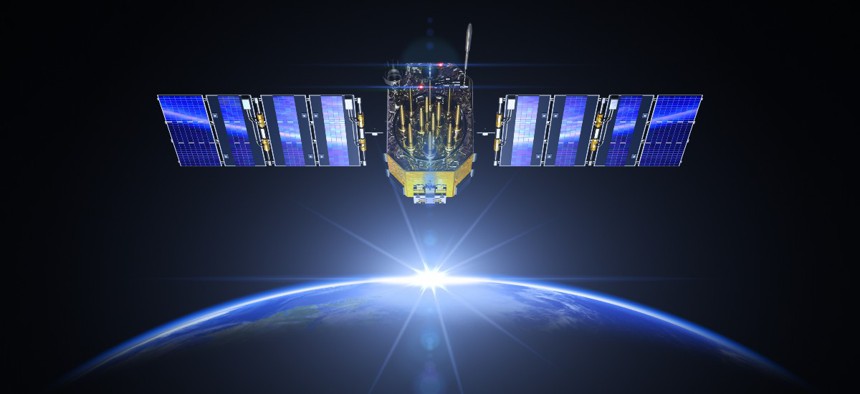Planned Next-Gen Satellites Can Help Address Extreme Weather Challenges, Officials Say

BlackJack3D/Getty Images
A Wednesday hearing explored the capabilities of the new GeoXO satellites to provide better data for weather forecasting and modeling.
Even as NASA and the National Oceanic and Atmospheric Administration gear up to launch the final satellite in the Geostationary Operational Environmental Satellites—or GOES-R—series in the next two years, officials are already looking to the capabilities possible in the upcoming generation of weather satellites.
That next generation of weather satellites is a geostationary extended observation system, also known as GeoXO. The GeoXO mission will continue and expand on the potential of the current GOES-R—with the first launch scheduled for 2032 and five more satellites slated after that. It has planned observation through 2055.
“We’re looking toward the next generation of geostationary satellites, the GeoXO program, which will include the addition of ocean and atmospheric monitoring,” John Gagosian, NASA’s Joint Agency Satellite Division director, told the House Subcommittee on Space and Aeronautics and the Subcommittee on Environment Wednesday.
NOAA’s “GeoXO will bring new capabilities to address emerging environmental challenges of the future in support of U.S. weather, ocean and climate operations,” Gagosian said. “NOAA’s radiation monitors in geostationary orbit are critical sources of data for NASA’s Space Weather research.”
Dr. Stephen Volz, assistant administrator of National Environmental Satellite, Data and Information Services at NOAA, described the improvements the new satellites will provide.
“One of GeoXO’s advanced capabilities is a hyperspectral infrared sounding,” Volz said. “The sounder will provide significantly improved, real-time, vertically resolved observations of wind speed and direction. With this data, experts will be able to better track and monitor storms and better project behavior [of] fire and smoke.”
Volz noted that satellite data makes up about 90% by volume of the data NOAA uses for weather forecast modeling. Current satellites used by the agency are the Joint Polar Satellite System—or JPSS—and GOES, which are the backbone for current weather forecasts and modeling. As noted in the hearing, the GOES program has had issues with increasing costs and delays, though both agencies have worked to address these challenges.
Volz added that another challenge with current satellite technology is near real-time observations because of obstacles in lower levels of the atmosphere.
“That is probably one of the primary benefits we’re going to see from our geostationary hyperspectral infrared sounder,” Volz said. “The imagery we have right now can be blocked by clouds and has limitations in the vertical disseminate, vertical accuracy or resolution of events. Whereas the hyperspectral sounder will allow us to be much more accurate in measuring the wind speeds and direction at multiple levels of the atmosphere.”
According to Volz, the next generation of weather satellites will also help improve detecting and pinpointing the locations of fires because of higher spatial resolution and improved bandwidth frequency. Additionally, using hyperspectral infrared sounder––a key component of GeoXO––will help improve weather forecasts as it is a geostationary orbit sounding capability that will be able to help with forecasting flooding.
Ranking member Brian Babin, R-Texas, noted the importance of partnering with the private sector to utilize their “innovation and resources” to advance these technologies and provide better weather forecasts.
“Recently, we completed the NOAA architecture study to help define our next generation missions and integrate NOAA’s assets with those of our international commercial partners,” Volz said. “We have demonstrated with our current programs the value of buying instruments and other central program elements in bulk to reduce mission costs and risks and the value of selectively using different contracting approaches. Those geostationary satellites provide the only continuous, near-real-time observations of the Western Hemisphere supporting severe weather and extreme events, watches and warnings.”
Gagosian noted that NASA is looking to work with the private sector for this endeavor as they “have best practices that they’ve developed over the years for efficient operations.” Specifically, the agency has “explored new acquisition strategies that rely on the private sector for mission operations and data transport.”
Energy Subcommittee Ranking Member Stephanie Bice, R-Okla., emphasized the importance of making weather data useful and accessible to communities. For this, she highlighted the importance of high-performance computing to help improve weather modeling.
“We also see the potential in cloud computing, artificial intelligence and machine learning to enable research and improved data products,” Gagosian said.
While NOAA and NASA are working on the next generation of weather satellites, Volz asserted that a better understanding of the data is also important to improve weather forecasts and models, in addition to improved technology. He added that it is important to deliver data to users in a way that is helpful to them. As a result, NOAA is working to migrate its data to the cloud, to allow for an easier and faster dissemination of this information. However, this faster format does not allow NOAA to tailor the data to the user as well as the agency would like, according to Volz.






